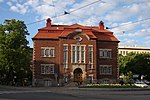Hakaniemi

Hakaniemi (Swedish Hagnäs) is an unofficial district of Helsinki, the Finnish capital. It covers most of the neighbourhood of Siltasaari. It is considered a part of the Helsinki city center. Historically, it was often associated with the working class and workers' associations. However, the cost of living has risen considerably in recent years and is now on par with that of the rest of central Helsinki. The best-known features of Hakaniemi include a large and lively marketplace, Oriental food stores with a good variety of Asian imported products the headquarters of several trade unions, the headquarters of the Social Democratic Party of Finland and the Left Alliance Party and the Helsinki Hilton hotel. Famous buildings include the round Ympyrätalo building (architects Heikki and Kaija Sirén, 1968) and the Hakaniemi Market Hall (architect Karl Hård af Segerstad, 1914). The Hakaniemi market square was built on reclaimed land. It has been the site of a farmers' market since 1897.
Excerpt from the Wikipedia article Hakaniemi (License: CC BY-SA 3.0, Authors, Images).Hakaniemi
Siltasaarenkatu, Helsinki Kallio (Central major district)
Geographical coordinates (GPS) Address Website Nearby Places Show on map
Geographical coordinates (GPS)
| Latitude | Longitude |
|---|---|
| N 60.179166666667 ° | E 24.950555555556 ° |
Address
Hakaniemi
Siltasaarenkatu
00530 Helsinki, Kallio (Central major district)
Finland
Open on Google Maps










